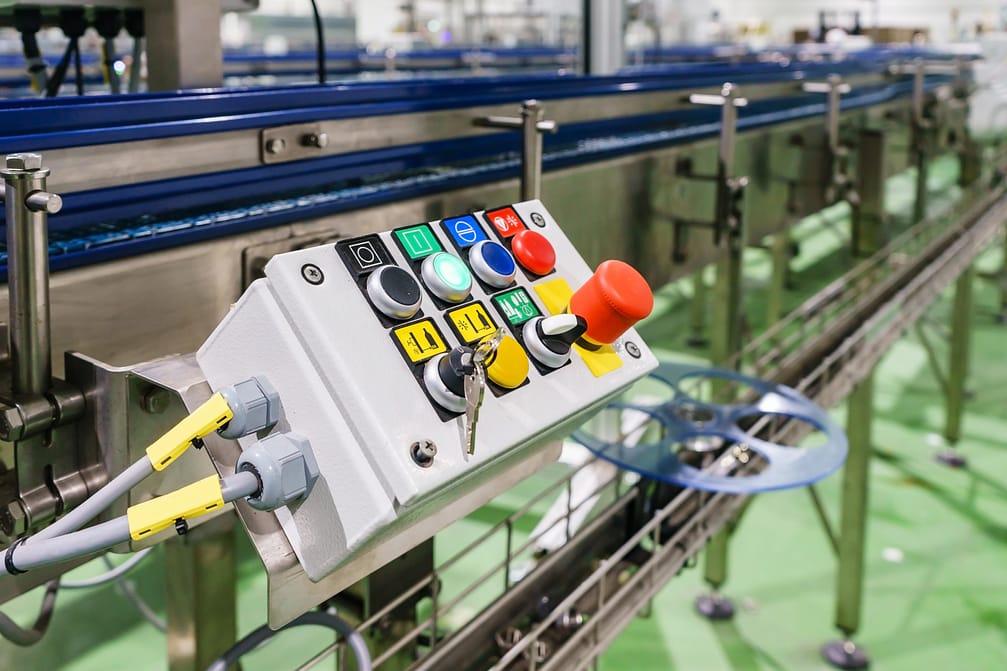Keep your employees safe in the workplace
Conveyors are very helpful in moving material and supplies within a facility. However, they are a common cause of injury in a plant. We’ve compiled this list of safety practices that will help keep you and your coworkers safe.
1. Don't sit, stand, or walk on conveyors

Conveyors are never meant to be occupied by a person.
- Conveyors have many features, including pinch points that can catch clothing or people and cause serious injuries.
- A limb stuck in a pinch point can be severely damaged or even torn off.
- Industrial conveyors are not designed for people so you should never ride on conveyors.
2. Make sure conveyor controls are operating correctly

Controls that don’t work properly can cause serious problems.
- Inspect your conveyor controls to make sure no employee has misused, modified, or disconnected them.
- Controls should be easy to read and use, as well as easily accessible.
- Place emergency stops in highly visible and accessible locations.
3. Keep hair, clothing, jewelry, and other loose items away

Conveyors can catch loose clothes or long hair, resulting in severe injuries.
- Make sure long hair is tied back or tucked under a cap.
- Don't wear bracelets, rings, watches, or other jewelry.
- Avoid wearing baggy clothing; remove ties or tuck them into your shirt.
4. Check that all conveyor guards are in place

Don’t operate a conveyor if guards are not securely mounted.
- Conveyors contain gears, chains, belts, and other moving parts that can be hazardous if exposed.
- Employees should not be able to bypass, remove, or alter conveyor guards.
- Guard openings should be small enough to keep workers from entering danger zones.
5. Be watchful of pinch points

Conveyors are filled with pinch points by their very nature.
- Conveyors contain gears, chains, belts, and other moving parts that can be hazardous if exposed.
- Employees should not be able to bypass, remove, or alter conveyor guards.
- Guard openings should be small enough to keep workers from entering danger zones.
6. Alert management of any potential safety or operational concerns

If you see something, say something.
- The best way to correct an unsafe situation (e.g. loose guards, a person riding the conveyor) is to alert the person responsible for the area.
- Make sure it is clear who the point of contact is and how to reach that person.
- Training about safety issues and when to report them should be made available to all employees.
7. Follow lock-out/tag-out procedures

Failure to do so exposes employees to life-threatening injuries.
- Secure conveyor systems before maintenance or repair by following proper lock-out/tag-out procedures.
- Lock-out/tag-out procedures prevent equipment from being powered up while maintenance or repairs are being done.
- Conveyor operators must be properly trained to perform lock-out/tag-out procedures.
8. Allow only authorized personnel to operate or maintain the conveyor

This ensures technician safety and optimal conveyor performance.
- Material handling equipment can be dangerous to those who do not understand how to safely work on it.
- When something needs to be fixed, contact your trained maintenance person.
- Only those employees who are trained to operate and perform maintenance on conveyors should do so.
Now that you know these eight conveyor safety tips, share them with your employees so they know what to keep in mind the next time they’re working on, near, or around a conveyor system.









3 comments
Thanks for providing an informative blog post on conveyor belts. You have written an impressive blog about what safety instructions should be considered while using conveyor belts. Keep posting more interesting blogs.
Sorting conveyors are an essential component in modern material handling systems, significantly enhancing efficiency and accuracy. These conveyors automate the sorting process, reducing manual labor and minimizing errors. They’re particularly useful in industries like logistics, manufacturing, and food processing, where rapid and precise sorting is crucial. Conveyor & Caster offers customizable options to meet specific needs, ensuring streamlined operations and improved productivity. Highly recommend for businesses looking to optimize their sorting processes!
I found the blog very informative and gained valuable knowledge from it.